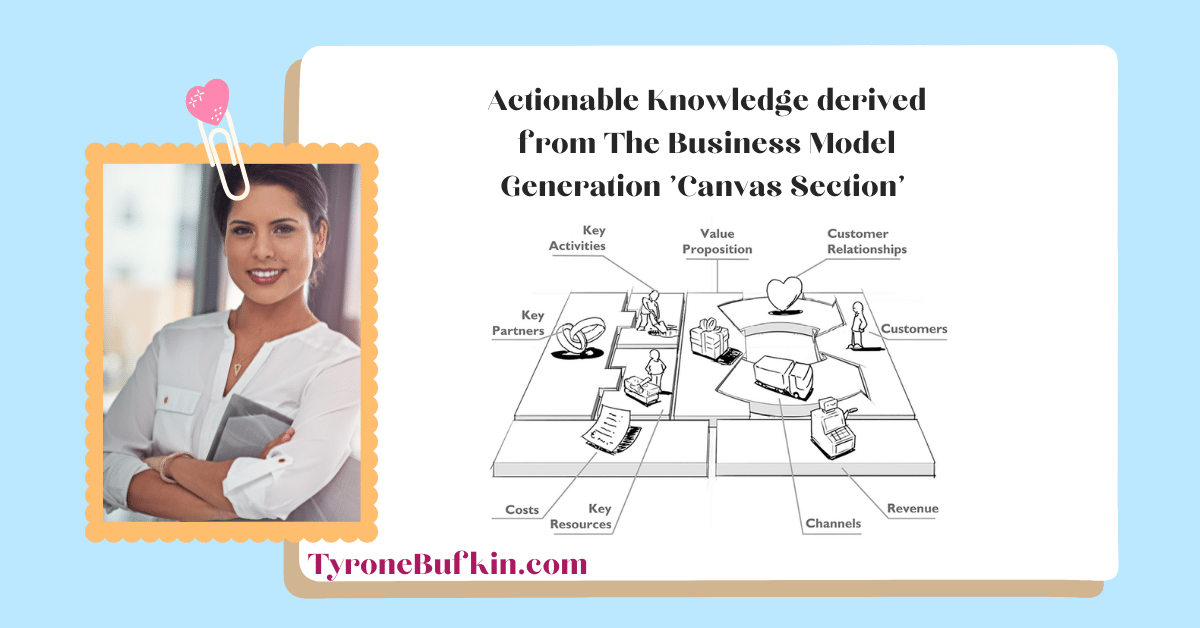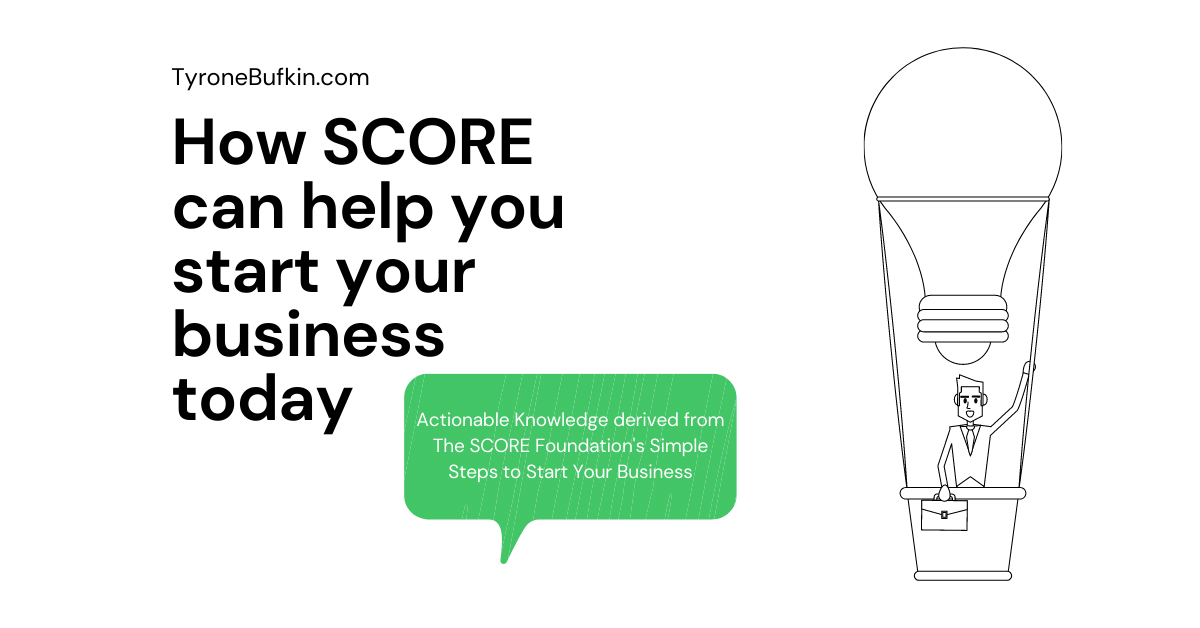THE FIDUCIARY ACTIONABLE KNOWLEDGE IN THIS POST MAY CONTAIN AFFILIATE LINKS. WE GET A COMMISSION, AT NO COST TO YOU, IF YOU DECIDE TO CLICK THROUGH CERTAIN LINKS. WE ONLY RECOMMEND PRODUCTS OR ORGANIZATIONS THAT WE BELIEVE WILL PROVIDE YOU WITH REAL RESULTS. THE INFOMATION IN THIS POST MAY HAVE BE DERIVED FROM THE SOURCES FOUND IN THE 'WORKS CITED' SECTION AT THE BOTTOM OF THE PAGE. PLEASE READ OUR DISCLOSURE PAGE FOR MORE INFO.
The Business Model Canvas of the Business Model Generation is a framework for visionaries, game-changers, and challengers striving to defy outmoded business models and design tomorrow's enterprises. If your organization needs to adapt to harsh new realities, but you don't yet have a strategy that will get you out in front of your competitors, you need to sketch out your Business Model Canvas.
I know you are just as busy as I am so I've organized the information into three sections; The outcome and actions to achieve it, A condensed Session by Session summary, and finally my full summary.
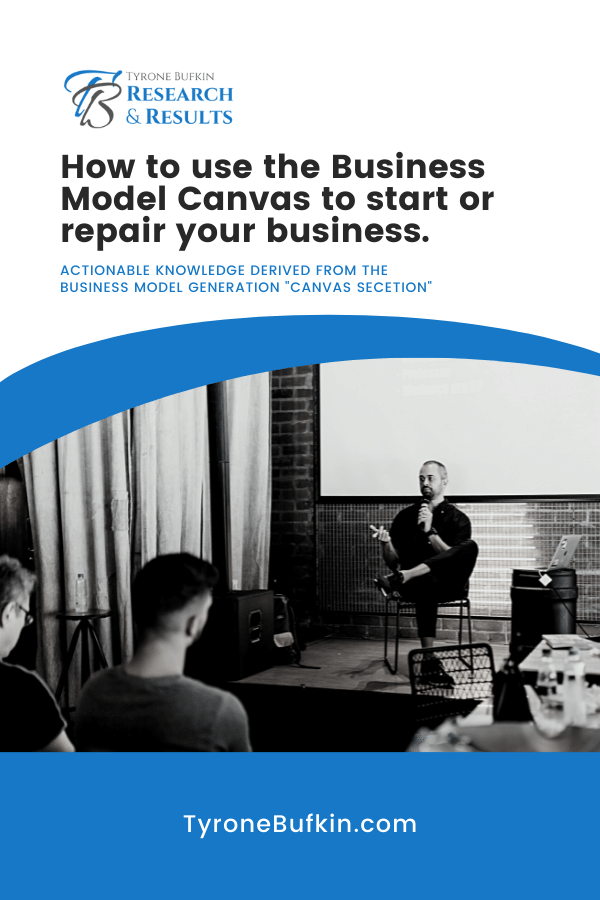
Outcome: Sketch out your Business Model Canvas with your team.

List of Action Items
- Print out the Business Model Canvas template on a large surface.
- Define the needs and number of customer segments that your organization aims to reach and serve.
- Figure out how to solve customer problems and satisfy customer needs with value propositions.
- Uncover the channels that will deliver the value proposition to customers.
- Establish and maintain customer relationships with each customer segment.
- Define Revenue streams representing the cash a company generates from each customer segment.
- Uncover the Key Resources required to offer and deliver the previously described elements
- Map out the Key Activities are required to offer and deliver the previously described elements.
- Identify and outsource activities best completed outside the enterprise through key partnerships.
- Define the cost structure describing all costs incurred to operate a business model.
Condensed Session by Session Summary
A business model describes the simple but complete blueprint of how an organization creates, delivers, and captures value to its customers, offer, infrastructure, and financial viability. The Nine Building blocks of the Business Model Canvas are Customer Segments, Value Propositions, Channels, Customer Relationships, Revenue Streams, Key Resources, Key Activities, Key Partnerships, and Cost Structure (Definition of a Business Model).
The Customer Segments building block is defined by the needs and number of customer segments the organization aims to reach and serve. The different types of customer segments include Mass Market, Niche Market, Segmented, Diversified, and multi-sided platform. Mass Market business models don't distinguish between different customer segments, niche market models serve on specific segments, segmented models serve slightly different segments, diversified models serve very different segments, and multi-sided platform models serve two or more interdependent segments (Customer Segments).
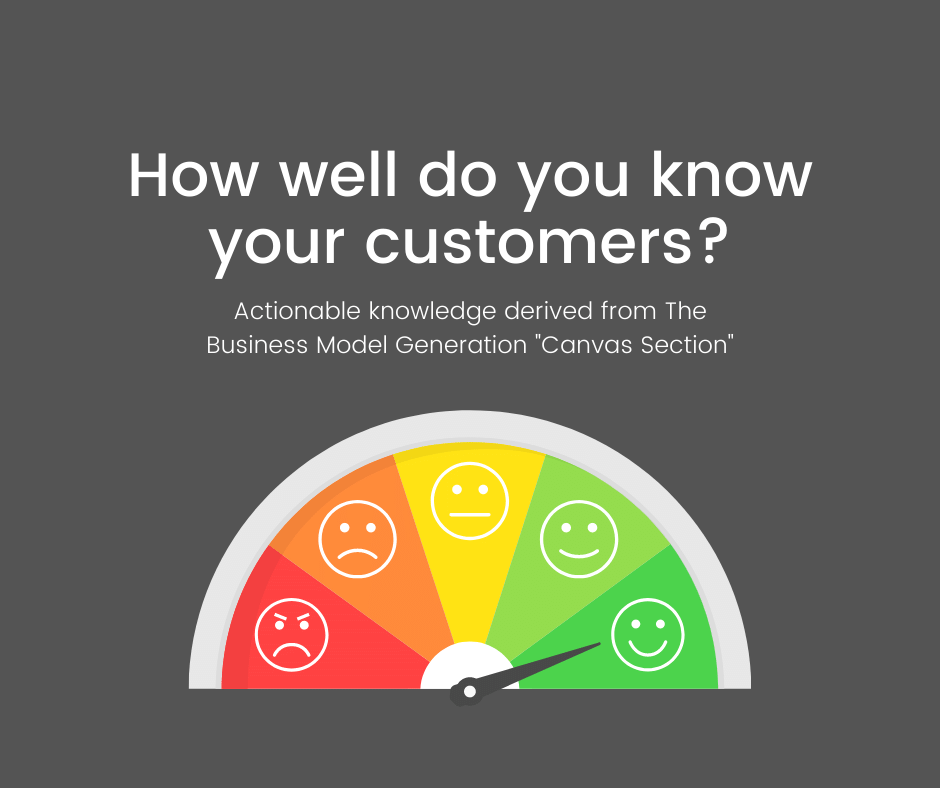
An organization seeks to solve customer problems and satisfy customer needs with value propositions using the bundle of products and services. Values may be quantitative (price, or speed of service) or qualitative (design or customer experience) including newness, performance, customization, getting the job done, design, brand, price, cost reduction, risk reduction, accessibility, convenience, or usability (Value Propositions).
Value propositions are delivered to customers through communication, distribution, and sales channels. Channels have five distinct phases. Each channel can cover some or all of these phases, We can distinguish between direct channels and indirect ones, as well as between owned channels and partner channels. Partner channels lead to lower margins, but they allow an organization to expand its reach and benefit from partner strengths. Owned channels and particularly direct ones have higher margins, but can be costly to put in place and to operate. The trick is to find the right balance between the different types of channels, to integrate them in a way to create a great customer experience and maximize revenues. The channel phases are awareness, evaluation, purchase, delivery, and after-sales (Channels).
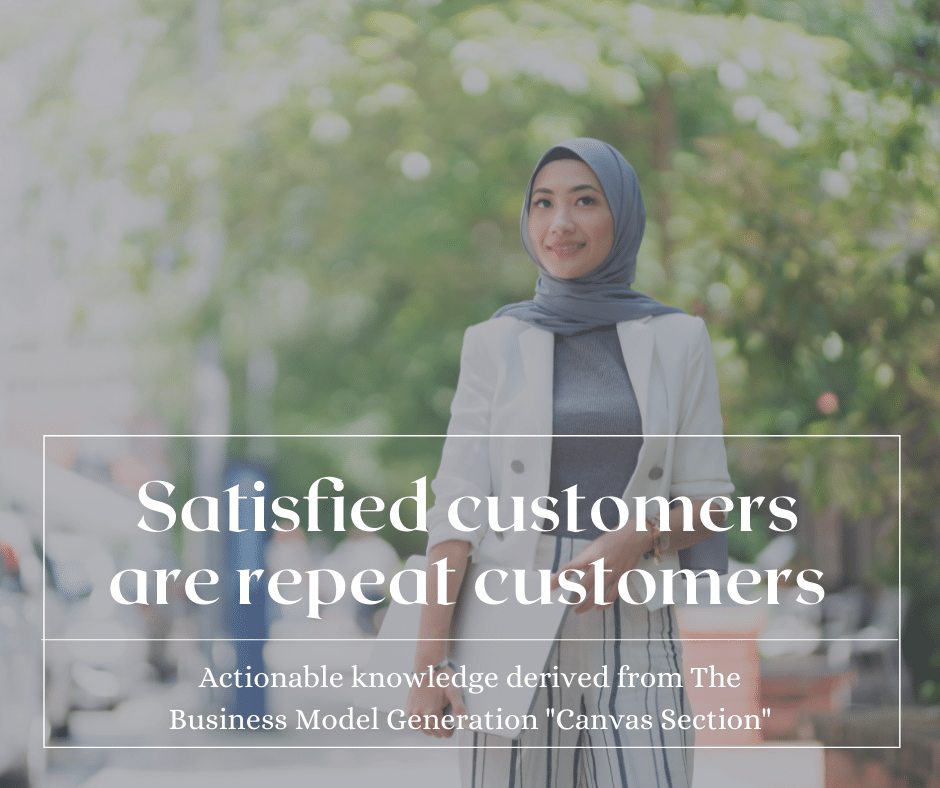
Customer relationships are established and maintained with each customer segment and deeply influence the overall customer experience. We can distinguish between several categories of customer relationships, which may co-exist in a company's relationship with a particular customer segment which are personal assistance, dedicated personal assistance, self-service, automated services, communities, and co-creation (Customer Relationships).
Revenue streams result from value propositions successfully offered to customers and represent the cash a company generates from each customer segment. A business model can involve two different types of revenue streams; Transaction revenues resulting from one-time customer payments and recurring revenues resulting from ongoing payments to either deliver a value proposition to customers or provide post-purchase customer support. Ways to generate revenue streams are assets sale, usage fee, subscription fees, lending/renting/leasing, licensing, brokerage fees, and advertising. The two types of pricing mechanisms are fixed menu pricing based on static variables and dynamic pricing which changes based on market conditions (Revenue Streams).
Key resources are the assets required to offer and deliver the previously described elements. Key resources can be physical, financial, intellectual, human, and can be owned or leased by the company or acquired from key partners (Key Resources).
Key activities are those required to offer and deliver the previously described elements. These are the most important actions a company must take to operate successfully including production, problem-solving, and platform/network (Key Activities).

Some activities are outsourced and some resources are acquired outside the enterprise through key partnerships. Alliances form using four different types of partnerships; strategic alliances between non-competitors, strategic partnerships between competitors, joint ventures to develop new businesses, and buyer-supplier relationships to assure reliable supplies. These types of partnerships are usually motivated by optimization and economy of scale, reduction of risk and uncertainty, and acquisition of particular resources and activities (Key Partnerships).
The cost structure describes all costs incurred to operate a business model particularly the most important costs incurred while operating. Such costs can be calculated relatively easily after defining key resources, key activities, and key partnerships. It can be useful to distinguish between two broad classes of business model cost structures; cost-driven organizations focus on minimizing costs wherever possible and value-driven organizations instead focus on value creation. Cost structures characteristics are fixed costs, variable costs, economies of scale, and economies of scope (Cost Structure).
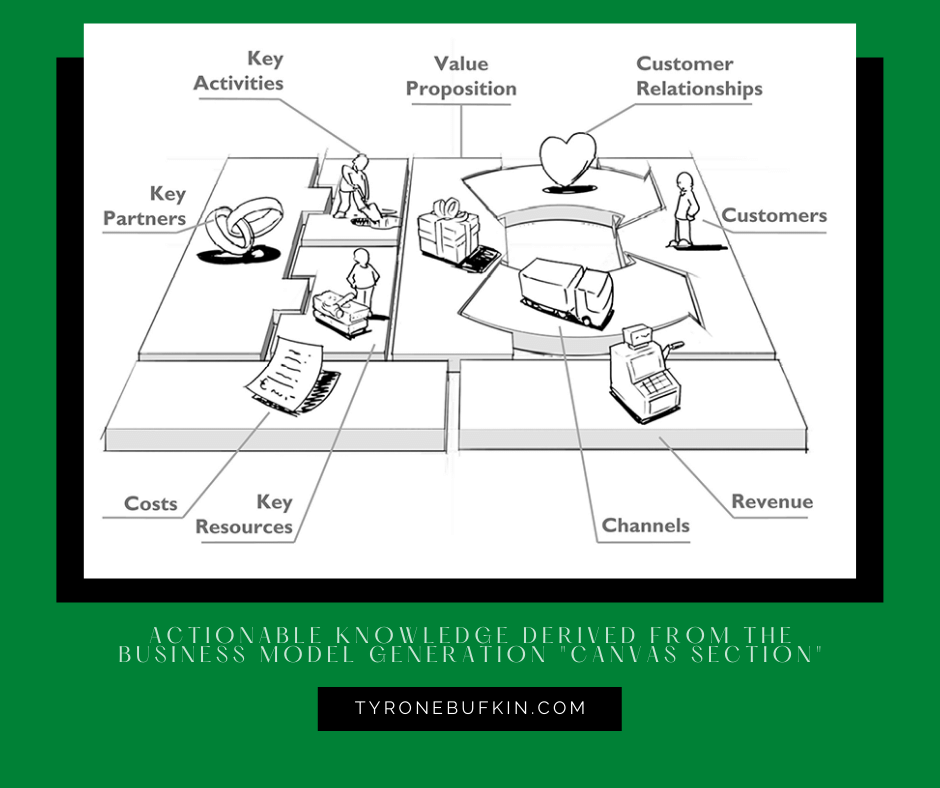
The Business Model Canvas works best when printed out on a large surface so groups of people can jointly start sketching and discussing business model elements (The Business Model Canvas Template).

The Business Model Canvas can be used to establish and externalize a business. Finally taking an idea out of your head and into a strategy that would make it real. The Business Model Canvas is also a reality check for existing businesses by finding cracks in the foundations of the business. It can be used as a universal tool to explain a business. For more information on the Canvas Section of the Business Model Canvas please continue reading.
Definition of a Business Model
A business model describes the rationale of how an organization creates, delivers, and captures value. A business model needs to be simple enough to facilitate discussion, be relevant, and be understood by everyone but doesn't oversimplify the complexities of how enterprises function. The concept presented in the following pages has been applied, tested around the world, and can become a shared language that allows you to easily describe and manipulate business models to create new strategic alternatives. A business model can best be described through nine basic building blocks that show the logic of how a company intends to make money by covering the four main areas of a business; customers, offer, infrastructure, and financial viability. The business model is like a blueprint for a strategy to be implemented through organizational structures, processes, and systems. The Nine Building blocks of the Business Model Canvas are Customer Segments, Value Propositions, Channels, Customer Relationships, Revenue Streams, Key Resources, Key Activities, Key Partnerships, and Cost Structure.
Every organization starts in someone's mind and is then must be shared in order to become real. Without a shared language to describe an organization, it is difficult to systematically challenge assumptions about one's business model and innovate successfully. If you don't challenge assumptions and innovate then your organization will die before it even starts.
Customer Segments
The Customer Segments Building Block defines the different groups of people or organizations an enterprise aims to reach and serve. Without profitable customers, no company can survive for long. In order to better satisfy customers, a company may group them into distinct segments with common needs. behaviors, and other attributes. An organization must make a conscious decision about which segments to serve and which to ignore. Once this decision is made, a business model can be carefully designed around a strong understanding of specific customer needs. Customer groups represent separate segments if their needs require and justify a distinct offer, they are reached through different distribution channels, they require different types of relationships, they have substantially different profitabilities and they are willing to pay for different aspects of the offer.
Business models focused on Mass Market don't distinguish between different customer segments, value propositions, distribution channels, and customer relationships; instead, they focus on one large group of customers with broadly similar needs and problems.
Business models targeting Niche Markets cater to the value proposition, distribution channels, and customer relationships to specific and specialized customer segments. Such business models are often found in supplier-buyer relationships such as car part manufacturers.
Some business models are Segmented with slightly different needs and problems. The retail arm of a bank like Credit Suisse may distinguish between a large group of customers possessing assets up to $100,000 and a small group whose net worth exceeds $500,000. Both segments are similar but have varying needs and problems.
An organization with a Diversified customer business model serves two unrelated customer segments with very different needs and problems. Amazon diversified its retail by catering to a totally different customer segment selling online storage space and on-demand server usage.
Some organizations, using a Multi-Sided Platform, serve two or more interdependent customer segments. A credit card company needs a large base of credit card holders and a large base of merchants who accept those credit cards. Both segments are required to make the business model work.
For whom are you creating value? Who are your most important customers? You cannot be all things to all people so You must know who you are selling to. Once you understand your customer segment who must learn to listen to their very changing needs and innovate your organization accordingly.
Value Propositions
The Value Propositions Building Block describes the bundle of products and services that create value for a specific customer segment. The value proposition is the reason a customer will turn to one company over another because it better solves the problem or satisfy the need with innovative or disruptive product offers or simply added features. A value proposition creates value for a customer segment through a distinct mix of elements catering to that segment's needs. Values may be quantitative (price, or speed of service) or qualitative (design or customer experience)
Some value propositions use Newness to satisfy an entirely new set of needs that customers previously didn't perceive because there was no similar offering.
Improving product or service Performance has traditionally been a common way to create value but improved performance has its limits.
Customization and co-creation of products and services to meeting the specific needs of individual customers or customer segments creates value. This approach allows for customized products and services, while still taking advantage of economies of scale.
Value can be created simply by helping a customer with "Getting the Job Done". Allowing a company the ability to rely on your product or service, frees them up to focus on running their business.
Design is an important but difficult element to measure how much it stands out due to a superior design.
Customers may find value in the simple act of using and displaying a specific Brand or status.
Offering similar value at a lower price, or free offers is a common way to satisfy the needs of price-sensitive customer segments but it has important implications for the rest of a business model.
Helping customers with Cost Reduction is an important way to create value. This relieves the buyers from the expense of purchasing your product or service.
Customers value Risk Reduction of the risk they incur when purchasing products or services usually in the form of money-back or service-level guarantee.
Improving the Accessibility of products and services to customers who previously lacked access is another way to create value. This can result from business model innovation, new technologies, or a combination of both.
Creating Convenience or Usability can create substantial value.
What value do you deliver to the customer? Which one of your customer's problems are you helping to solve? Which customer needs are you satisfying? What bundles of products and services are you offering to each customer segment? Your value proposition is the reason a customer will buy from over your competitor.
Channels
The channels building block describes how a company communicates with and reaches its customer segments to deliver a value proposition. Channels are customer touchpoints that play an important role in the customer experience. Channels serve several functions including raising awareness among customers about a company's products and services, helping customers evaluate a company's value proposition, allowing customers to purchase specific products and services, delivering a value proposition to customers, and providing post-purchase customer support.
Channels have five distinct phases. Each channel can cover some or all of these phases, We can distinguish between direct channels and indirect ones, as well as between owned channels and partner channels. Finding the right mix of channels to satisfy how customers want to be reached is crucial in bringing a value proposition to market. An organization can choose between reaching its customers through its own channels, through partner channels, or through a mix of both. Owned channels can be direct, such as an in-house sales force or a website, or they can be indirect, such as retail stores owned or operated by the organization. Partner channels are indirect and span a whole range of options, such as wholesale distribution, retail, or partner-owned websites. Partner channels lead to lower margins, but they allow an organization to expand its reach and benefit from partner strengths. Owned channels and particularly direct ones have higher margins, but can be costly to put in place and to operate. The trick is to find the right balance between the different types of channels, to integrate them in a way to create a great customer experience and maximize revenues.
- Channel Types
- Partner or Own
- Indirect or Direct
- Channel Phases
- How do we raise awareness about our company's products and services?
- How do we help customers evaluate our organization's value proposition?
- How do we allow customers to purchase specific products and services?
- How do we deliver a value proposition to customers?
- How do we provide post-purchase customer support?
- Channel Phases
- Indirect or Direct
- Partner or Own
Through which channels do your customer segments want to be reached? How are you reaching them now? How are our channels integrated? Which ones work best? Which ones are most cost-efficient? How are we integrating them with customer routines? All the time, money, and energy your organization spends on the value proposition will be wasted if you don't find the right channel to reach your customer.
Customer Relationships
The customer relationships building block describes the types of relationships a company establishes with specific customer segments and deeply influences the overall customer experience. Relationships can range from personal to automated and may be driven by customer acquisition, customer retention, and boosting sales (upselling). We can distinguish between several categories of customer relationships, which may co-exist in a company's relationship with a particular customer segment.
The Personal Assistance Customer Relationship is based on human interaction. The customer can communicate with a real customer representative to get help during the sales process or after the purchase is complete.
Dedicated Personal Assistance involves a customer representative specifically dedicated to an individual client. It represents the deepest and most intimate type of relationship and normally develops over a long period of time.
In a Self-Service type of relationship, a company maintains no direct relationship with customers instead it provides all the necessary means for customers to help themselves.
An Automated Services relationship mixes a more sophisticated form of customer self-service with automated processes. It can recognize individual customers and their characteristics and offer information related to orders or transactions simulating a personal relationship.
Increasingly, companies are utilizing user Communities to become more involved with customers/prospects and to facilitate connections between community members. Many companies maintain online communities that allow users to exchange knowledge and solve each other's problems. Communities can also help companies better understand their customers.
More companies are going beyond the traditional customer-vender relationship to Co-create value with customers. Some companies engage customers to assist with the design of new and innovative products.
What type of relationship does each of our customer segments expect us to establish and maintain with them? Which ones have we established? How costly are they? How are they integrated with the rest of our business model? The best way to uncover the relationship your customers require is to simply ask them and do what works best for your customers and your organization.
Revenue Streams
The revenue streams building block represents the cash a company generates from each customer segment (cost must be subtracted from revenues to create earnings). If customers comprise the heart of a business model, revenue streams are its arteries. A company must ask itself, for what value is each customer segment truly willing to pay? Successfully answering that question allows the firm to generate one or more revenue streams from each customer segment. Each revenue stream may have different pricing mechanisms, such as fixed list prices, bargaining, auctioning, market dependent, volume dependent, or yield management.
A business model can involve two different types of revenue streams; Transaction revenues resulting from one-time customer payments and recurring revenues resulting from ongoing payments to either deliver a value proposition to customers or provide post-purchase customer support.
The most widely understood revenue streams are derived from the Asset Sale of ownership rights to a physical product.
This revenue stream is generated by a Usage Fee for a particular service. The more a service is used, the more the customer pays.
Subscription Fees are generated by selling continuous access to a service.
The Lending/Renting/Leasing revenue stream is created by temporarily granting someone the exclusive right to use a particular asset for a fixed period in return for a fee. For the lender, this provides the advantage of recurring revenues.
The Licensing revenue stream is generated by giving customers permission to use protected intellectual property in exchange for licensing fees. Licensing allows rightsholders to generate revenues from their property without having to manufacture a product or commercialize a service.
The Brokerage Fee revenue stream derives from intermediation services performed on behalf of two or more parties.
The Advertising revenue stream results from fees for advertising a particular product, service, or brand.
Each revenue stream might have different pricing mechanisms. The type of pricing mechanism chosen can make a big difference in terms of revenues generated. The two main types of pricing mechanisms are fixed and dynamic pricing. Fixed Menu Pricing is based on static variables. List prices are fixed for individual products, services, or other value propositions. Product feature depends on the number or quality of value proposition features. The price depends on the type and characteristics of a customer segment. Price is a function of the quantity purchased. Dynamic Pricing changes based on market conditions. Price is negotiated between two or more partners depending on negotiation power and/or negotiation skills. The price depends on inventory and time of purchase. The real-time market price is established dynamically based on supply, demand, and the outcome of competitive bidding.
For what value are our customers really willing to pay? For what do they currently pay? How are they currently paying? How would they prefer to pay? How much does each revenue stream contribute to overall revenues? You could have the perfect solution for a client but if you price it wrong, the customer may not be able to purchase it.
Key Resources
The key resources building block describes the most important assets required to make a business model work. Every business model requires key resources that allow an enterprise to create and offer a value proposition, reach markets, maintain relationships with customer segments, and earn revenues. Different key resources are needed depending on the type of business model. Key resources can be physical, financial, intellectual, human, and can be owned or leased by the company or acquired from key partners.
The Physical category includes assets such as manufacturing facilities, buildings, vehicles, machines, systems, point-of-sales systems, and distribution networks.
Intellectual resources such as brands, proprietary knowledge, patents and copyrights, partnerships, and customer databases are increasingly important components of a strong business model. Intellectual resources are difficult to develop but when successfully created may offer substantial value.
Every enterprise requires Human resources, but people are particularly prominent in certain business models.
Some business models call for Financial resources and/or financial guarantees, such as cash, lines of credit, or a stock option pool for hiring key employees.
What key resources do your value propositions require? Our distribution channels? Customer relationships? Revenue streams? When most businesses fail they credit a lack of resources as the reason, but it's truly a lack of resourcefulness. After you figure out what resources are vital to your operations, it is your responsibility to figure out how to get them.
Key Activities
The key activities building block describes the most important things a company must do to make its business model work. These are the most important actions a company must take to operate successfully. Like key resources, they are required to create and offer a value proposition, reach markets, maintain customer relationships, and earn revenues but differ depending on the business model type.
Production activities relate to designing, making, and delivering a product in substantial quantities and/or of superior quality.
Problem-solving relate to coming up with new solutions to individual customer problems that usually call for knowledge management and continuous training.
Business models designed with a Platform/Network as a key resource require that the company continually develop and maintain its platform.
What key activities do your value propositions require? Our distribution channels? Customer relationships? Revenue streams? This is what everyone actually sees in an organization and typically judges but an organization should not get caught up and completing activities for the sake of it. Organizations should focus on results and the activities required to accomplish those results.
Key Partnerships
The key partnerships building block describes the network of suppliers and partners that make the business model work. Companies forge partnerships for many reasons, and partnerships are becoming a cornerstone of many business models. Companies create alliances to optimize their business models, reduce risk, or acquire resources distinguishing between four different types of partnerships; strategic alliances between non-competitors, strategic partnerships between competitors, joint ventures to develop new businesses, and buyer-supplier relationships to assure reliable supplies.
The most basic form of partnership or buyer-supplier relationship is Optimization and Economy of Scale designed to optimize the allocation of resources and activities, reduce cost, and outsourcing or sharing infrastructure. It is illogical for a company to own all resources or perform every activity by itself.
Partnerships can help with the Reduction of Risk and Uncertainty in a competitive environment characterized by uncertainty. It is not unusual for competitors to form a strategic alliance in one area while competing in another.
Few companies own all the resources or perform all the activities described by their business models. Rather, they extend their own capabilities by relying on the Acquisition of Particular Resources and Activities from other firms. Such partnerships can be motivated by the need to acquire knowledge, licenses, or access to customers.
Who are your key partners? Who are your key suppliers? Which key resources are we acquiring from partners? which key activities do partners perform? It's more than not being able to run your business alone; it is counterproductive. If you don't find the right partners then you will waste your time and your business in areas not suited to your talents.
Cost Structure
The cost structure describes all costs incurred to operate a business model. This building block describes the most important costs incurred while operating under a particular business model. Creating and delivering value, maintaining customer relationships, and generating revenue all incur costs. Such costs can be calculated relatively easily after defining key resources, key activities, and key partnerships. Some business models are more cost-driven than others. It can be useful to distinguish between two broad classes of business model cost structures; cost-driven and value-driven that many business models fall in between these two extremes.
Cost-Driven business models focus on minimizing costs wherever possible. This approach aims at creating and maintaining the leanest possible cost structure, using low price value propositions, maximum automation, and extensive outsourcing.
Value-Driven companies are less concerned with the cost implications of a particular business model design and instead focus on value creation.
Cost structures can have the following characteristics:
Fixed Costs remain the same despite the volume of goods or services produced. Examples include salaries, rents, and physical manufacturing facilities.
Variable Costs vary proportionally with the volume of goods or services produced.
Economies of Scale are costs advantages that a business enjoys as its output expands.
Economies of Scope are cost advantages that a business enjoys due to a larger scope of operations.
What are the most important costs inherent in your business model? Which key resources are most expensive? Which key activities are most expensive? Figuring out cost should be the last step of defining your business model but must redefine the rest of your business model. If you determine your cost is too high then you need to find a financial partner or if you are not attracting your ideal customer perhaps you are not added enough value.
The Business Model Canvas Template
The nine business model building blocks form the basis for a handy tool, which we call the Business Model Canvas. This tool resembles a painter's canvas which allows you to paint pictures of new or existing business models. The Business Model Canvas works best when printed out on a large surface so groups of people can jointly start sketching and discussing business model elements with Post-it notes or board markers. it is a hands-on tool that fosters understanding, discussion, creativity, and analysis.
Customer Segments, Channels, Customer Relationships, and Revenue Streams come from the right brain which controls value and emotion. Key Resources, Key Activities, Key Partnerships, and cost structure come from the left brain which controls logic and efficiency. Value Proposition will come from both the right and left brain working together.
Designing your Business Model Canvas will help you translate your business plans into your business processes. It can give you the ability to get you unstuck on details and improve the business as a whole step by step. It is also an amazing framework that can be used to describe your business to potential funding partners, customers, and your own employees.

Works Cited
Osterwalder, Alexander. "Business Model Canvas Section" Business Model Generation: A Handbook for Visionaries, Game Changers, and Challengers, Yves Pigneur, 2010.
